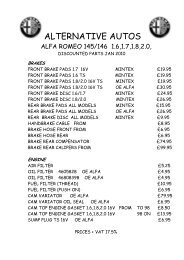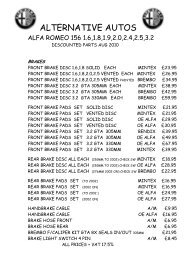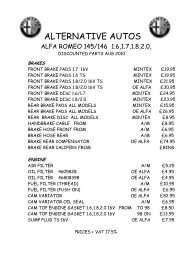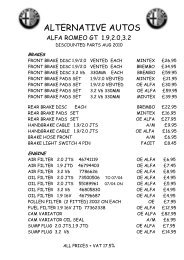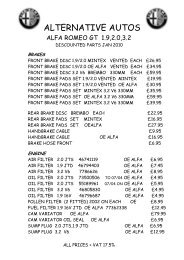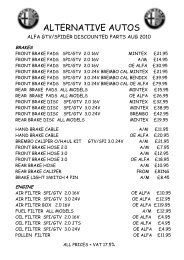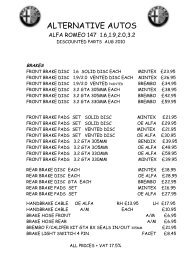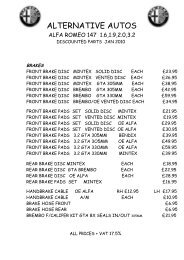Alfa Romeo 156 Brake Replacement
Alfa Romeo 156 Brake Replacement
Alfa Romeo 156 Brake Replacement
- No tags were found...
Create successful ePaper yourself
Turn your PDF publications into a flip-book with our unique Google optimized e-Paper software.
<strong>Alfa</strong> <strong>Romeo</strong> <strong>156</strong> <strong>Brake</strong> <strong>Replacement</strong>Front DiscsFRONT DISCSTools Required:Once caliper assembly is off,remove the caliper mountingbrackets (4b). Remove the twobolts (4a) with a 19mm socket/spanner. These fix to wheel hubbehind disc.Clean up the caliper mountingsespecially where the caliperlocates and slides. Lubricatewith Copperslip or similar.The remove the small bolt/pin (1b) from the hub area ofthe disc (1a in lower image) and remove disc.Now’s the time to compare the old one with the newone!!Installation is reverse of above. Clean up the faces of thehub, and clean all the traces of oil/grease, etc., beforereplacing the disc. Remember the discs will be oiled toprevent corrosion and all traces will need to beremoved.Disc mounting pin (1b) torque settings are 0.8-1.3Nm.Disc caliper bracket bolts (4a) : 13.6-16.8Nm.Replace the caliper and pads as in “Front Pads” onpage 2.Fronts: Before and After ... maybe I should have painted them?!?Page 3 of 618 April 2005 11:54 am
<strong>Alfa</strong> <strong>Romeo</strong> <strong>156</strong> <strong>Brake</strong> <strong>Replacement</strong>Rear DiscsREAR DISCSParts Required:If you are using the opportunity fit new discs, youdon’t have to remove the caliper mountings. Butmight be wise and give them a good clean at thesame time. You’ll need a good strong 19mm ringspanner or narrow socket though as it’s impossibleto get a thick socket on the lower bolts due to thesuspension mountings. Luckily the disc will comeoff with this in place. Torquing the bolts will bedifficult with a ring spanner, so guess work may beneeded and some Loctite.Remove the disc mounting bolt/pin from the hubface and lift the disc away, angling it to clear the huband the caliper brackets.My discs were hard to remove and I had to resort totapping the disc from the back with a hammer whileturning it. The discs were the originals, so after 6 1/2years they tried to remain part of the hub!As with the fronts, give the hub a good clean and removeall traces of oil and grease from the new disc beforereplacing.If you do remove the caliper mountings, the bolts torquesetting is 4.7-5.8 Nm.The disc pin (1a) is 0.8-1.3 Nm.Copperslip all the moving parts and bolt everything backtogether.Page 5 of 618 April 2005 11:54 am
<strong>Alfa</strong> <strong>Romeo</strong> <strong>156</strong> <strong>Brake</strong> <strong>Replacement</strong>Bleeding the <strong>Brake</strong>sBLEEDING THE BRAKESIf you release fluid from the calipers through the bleed nipple when you pushed the pistonsback, you might have inadvertently got air in the system. This will lead to “spongy” brakes.BUt there is also the possibility that you have got old brake fluid in the system and this maybe starting to get contaminated with dirt and water. <strong>Brake</strong> fluid is hygroscopic which meansit will, over time, draw in moisture. This will reduce the fluids boiling point under heavybraking and may lead to you losing braking power at the worst possible moment.The recommended interval between complete changes is 2 years.To bleed the brakes you will need either a one-man kit that connects to a tyre valve andforces fluid into the master cylinder and through the system when you open the bleednipples. Alternatively you can get a simpler kit with a one-way valve on the tube. With thismethod you need to take care to ensure that the nipple is not too loose or air gets back in asthe pressure stops. I use one of these but get someone to sit in the car and pump the brakes.That way I can watch the fluid for colour and bubbles and also make sure the reservoir onthe master cylinder doesn’t get too low.If you use the simpler system, pump the brakes slowly, especially when bleeding the rears.The master cylinder may incorporate a brake balance valve which can trigger and preventthe proper flow of fluid to the rears. <strong>Alfa</strong> brakes are balanced to put most of the braking tothe fronts.There are a number of different ways in which you sequence the brakes:• Front first, rear last• Diagonally (n/s/f, o/s/r, o/s/f, n/s/r) or in reverse.• Working around the brakes, closest to master cylinder first (ie n/s/f, o/s/f, n/s/r, o/s/r)• The same, but starting furthest from the master cylinder (ie o/s/r, n/s/r, o/s/f, n/s/f)What is probably going to work here is to bleed the brakes as you finish each wheel or endas I did. Otherwise you will spend most of the time jacking the car up and down and removingwheels more often than you need to.Page 6 of 618 April 2005 11:54 am



